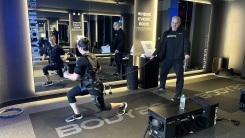Does Electrical Muscle Stimulation Really Supercharge Your Workouts?

I’ve tried a lot of strange workouts in the name of science, but there was no experience quite like seeing myself in an EMS suit for the first time. It’s all black, with straps and buckles everywhere. A long wire is about to connect me to a computer. I feel like I’m suiting up to operate a spaceship or a giant robot. Instead, I’m about to do lunges and pushups while being told that I’m getting a much better workout than those suckers who just go to a regular gym.
To try it out for myself, I accepted an offer of a free session at BODY20, a growing chain of EMS fitness studios. Its workouts are pricey, at $40 to $100 per session depending on where the studio is located and what kind of membership you sign up for.
So, is an EMS workout any better than the regular thing? Probably not. (We’ll get into the details in a minute.) But after seeing myself in the mirror, I kind of get the appeal.
What is EMS?
Electrical muscle stimulation (EMS) workouts are having a moment—not for the first time, and probably not for the last—based on their futuristic vibes and the fitness industry’s constant quest to sell you newer, cooler workouts than what everyone else is doing.
Electrical muscle stimulation is a family of techniques and technologies that trigger your muscles to contract by passing a mild electric current through your body. You may be familiar with some of the other uses of passing electric current through your body for health and fitness purposes, so I’ll describe them for comparison.
If you’ve used a TENS machine for pain relief, you know one type. You’ll put sticky electrodes on your skin, and turn on a handheld machine that’s connected to them by wires. TENS uses a mild current that feels like tingling, but it doesn’t make your muscles twitch or contract. The idea is that the tingling feeling interferes with pain signals. TENS stands for transcutaneous electrical nerve stimulation, meaning that the electrical current crosses the skin and the sensation is picked up by your nerves, but it’s not designed to contract muscles.
On the other hand, if you’ve used e-stim at a physical therapy appointment, that’s more like what’s happening in EMS workouts. When I was rehabbing after ACL surgery on my knee, rebuilding my quad muscle was a high priority. So I’d do leg presses and leg extensions, and at the end of the session, the PT would sit me down in a chair and apply sticky electrodes to my thigh. He’d slowly turn a knob and my quad would start contracting. When we hit a level that was mildly painful but tolerable, he’d leave the machine at that setting and we’d let the machine work my quad muscle for, as I recall, 10 minutes or so.
EMS workouts are closer to the e-stim machine, but the experience is very different. When you do an EMS workout, you’re strapped into a full-body suit that applies current to multiple muscle groups at once. The current isn’t as strong as in my PT sessions, but you also won’t just be sitting in a chair—you’ll be doing workouts while the electrodes make your muscles contract harder than they would from the exercises alone.
What happens in an EMS workout?
For my EMS workout, I showed up at a boutique fitness studio in a suburban area, next door to a veterinary clinic and within sight of a yoga studio. I had to sign a waiver that included a disclaimer recommending I not participate if I had a pacemaker, metal implants like plates or rods, or if I had epilepsy or cancer, or was pregnant. There were also items on the list that referenced dehydration, history of rhabdo, “strenuous physical exercise” in the last 72 hours, or another EMS workout in the previous five days.
The studio manager ran me through this and explained that I’d only be able to do a fairly short workout, without weights, my first day. Over the course of several sessions, people are introduced to longer and harder workouts, although you’re never doing more than 20 minutes in a session.
The area behind the desk was separated into two main rooms. There was a small fitness studio with mirrors and black flooring, where the workouts happen. Behind that was a room with an InBody scanner and several locker-like cubbies, brightly lit, with an XBody suit hanging in each.

(I played along and got the InBody scan, even though I know it’s not very accurate at determining body composition. It gave me flattering numbers, so I can’t be too mad.)
I was given a set of clothes to change into, a black form-fitting shirt with three-quarter length sleeves and a similarly cropped pair of pants.
I’d read that some EMS studios recommend not wearing underwear; at this studio, it seems you’re intended to keep yours on. Fine with me. I’ll just note, for planning purposes, that the clothes you wear under the suit will get wet. You might want to bring a change of dry undies for after.
While I put on the provided workout clothes, a Body20 staffer sprayed down the inside of the EMS suit that I would wear with water. Instead of sticking electrodes onto your body, like you might with a TENS machine, these electrodes are built into the suit. They each have an absorbent pad, and this is what she was wetting down. The water provides a conductor between the electrode and your skin. This means you’ll end up with wet patches on your biceps, your belly, your quads, your butt, and so on.
There are no electrodes on your calves or forearms, which didn’t surprise me; they’re not high priority muscles for most people to train. It did surprise me that the deltoids (your most obvious shoulder muscles) aren’t covered by electrodes, either. This must be to allow for movement at the shoulder, but it seemed like a strange omission when these are an area that many people want to train, either for looks or for functional reasons.
The workout itself was pretty basic, and short. The suit turns on, and you do a set of exercises, like lunges or squats. Then it turns off and you get a short break—just a few seconds—before you begin again.
Body20 offers strength and cardio classes. The strength classes are the main event, it seems, and the rules restrict you from doing them too often. Cardio workouts are done with less current going through the suit, and you’re moving around from exercise to exercise, much like those bodyweight circuit training videos you may have done on YouTube. Those workouts you’re allowed to do more often.
The staff at Body20 kept referring to rules about frequency and intensity as being set by “the FDA,” but when I asked about this in a follow-up email, I was told that the rules actually come from XBody, the suit manufacturer. The FDA does regulate EMS devices, and requires them to be cleared before use. They say they have gotten reports of shocks, burns, and other issues from devices that are illegally sold without being cleared. Bottom line, these rules from the manufacturer sound reasonable to me; I would be wary of buying any EMS equipment if you can’t verify that it’s FDA-cleared.
What does an EMS workout feel like?

Much like my e-stim experience at physical therapy, the beginning of my Body20 session involved the trainer turning up the current and asking me to stop him when it felt strong but bearable. Too high, and it could feel painful or crampy; too low, and you might not feel anything at all. (The e-stim at PT ended up being a lot stronger than what we were going for in this session.)
During the exercises, I could definitely feel the current making my muscle contractions stronger. Once or twice, doing a tricep movement, I felt my tricep sort of lock up. It wasn’t painful, but it felt like my arm wanted to stay straightened, almost like a mild cramp in my tricep.
There were dumbbells in the room, but we didn’t use these for my introductory workout. Instead, the trainer had me hold balls in my hands (like stress balls) and move them as if I were curling a dumbbell or doing a tricep kickback. Because of the current, these did feel like I was doing something.
That said, it wasn’t a hard workout. I kept hearing that I should expect to be sore afterward. Instead, I left the studio and headed straight to my weightlifting gym for my usual Monday workout (jerks, power snatches, power cleans, pendlay rows). I felt a little more fatigued than when I come to the workout fresh, but it was more like “just did a thorough warmup” than “did a whole ’nother workout first.” I was not sore the next day.
For somebody who doesn’t fling barbells around on a daily basis, it sounds reasonable to expect some soreness. The lighter, shorter workout for the first session makes sense if you don’t know how your body is going to react. But, based on my experience, it really doesn’t feel that different from a normal strength workout. If anything, it feels like less of a muscular stimulus than a strength day at the gym. You’re just not doing that much.
Are EMS workouts effective?
I’m a big-tent person when it comes to exercise: if you enjoy it, or if something about your chosen form of exercise gets you excited to do it and to keep coming back, then I support you, whether that’s Pilates or powerlifting or anything in between. I’m sure there are people who find it fun to do lunges in an EMS suit, but who wouldn’t bother doing lunges at home for free. If an EMS studio membership is what gets you into the habit (and you have the cash to burn), knock yourself out.
But we have to talk about something: the fact that every dang one of these studios makes a claim that EMS workouts are either better than regular workouts, or that they deliver the same results in a fraction of the time. For example, Bodystreet says you “only need to train 20 minutes per week.” Tummo says “One 20 minute session is equal to 3-4 days in the gym.” We202 says that a 20-minute class “equals 3 hours of traditional training.” Fitopia claims that its 20-minute workouts “are equivalent to 90 minutes of conventional workouts.” Body20, the place I went, is no exception: it say its classes let you “achieve results in just 20 minutes that would require hours in a traditional gym.”
So, of course, I asked about it. The PR person who had introduced me to Body20 sent a list of studies, and pointed specifically to this 2016 study that compared whole body EMS to high intensity resistance exercise. It concluded that EMS workouts “can be considered as a time-efficient but [pricey alternative] to [high intensity]-resistance exercise for people aiming at the improvement of general strength and body composition.”
I dug in, eager to crunch the numbers. As promised, the study included an EMS workout similar to the ones offered by Body20 and other studios. And it did find that both the EMS and non-EMS groups had similar increases in muscle mass and strength.
But the claim that you need hours in the gym to equal one EMS workout? That was not backed up at all by this study. The non-EMS workouts were 30 minutes long. (Or, to be more specific, 30.3 minutes plus or minus 2.3 minutes.) Even if the rest of the study’s results are completely true and trustworthy and apply to you personally, you’re only saving ten minutes per workout, not hours.
And I do have my doubts about the applicability of the study, even aside from the time issue. The study was done on 48 healthy men between the ages of 30 and 50, and all were “untrained,” so the results need to be taken with a grain of salt. Almost anything works on people with no exercise background. If you already go to some kind of gym or fitness studio, and are thinking of switching to EMS workouts, I wouldn’t expect much from EMS, to be honest. It might be just as good. It might be worse. We don’t have evidence that it would be better.
Taken together, I think the only reason to do EMS workouts would be if you think it’s a fun way to spend your money. (We all have our indulgences and our silly hobbies; maybe this is yours.) It’s not a smarter or better way to work out than going to a gym, or taking up some sporty hobby like running or rock climbing.



